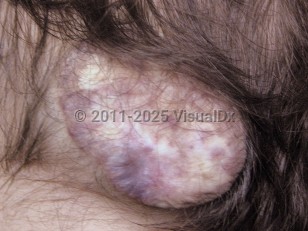Meningocele
Alerts and Notices
Important News & Links
Synopsis

A meningocele is a protrusion of the meninges without any accompanying spinal cord or nervous tissue. It typically occurs along the spinal column and can range in size. It is an occult form of spinal dysraphism resulting from a neural tube defect involving failed closure of the caudal neural tube. The etiology is multifactorial, and reduced folic acid is associated with the condition. A midline fluid-filled mass covered by skin is typically visible on examination. There is no spinal cord or nerve involvement; therefore, meningoceles are not typically associated with neurologic deficits. If spinal neural tissue is contained in the defect, it is called a meningomyelocele.
Cranial or high cervical meningoceles can be associated with hydromyelia or Chiari II malformations. If the cranial herniation contains neural tissue, it is called a meningoencephalocele.
Rarely, meningoceles can occur spontaneously or be iatrogenic (eg, occur after surgery).
Cranial or high cervical meningoceles can be associated with hydromyelia or Chiari II malformations. If the cranial herniation contains neural tissue, it is called a meningoencephalocele.
Rarely, meningoceles can occur spontaneously or be iatrogenic (eg, occur after surgery).
Codes
ICD10CM:
Q05.9 – Spina bifida, unspecified
SNOMEDCT:
171131006 – Meningocele
Q05.9 – Spina bifida, unspecified
SNOMEDCT:
171131006 – Meningocele
Look For
Subscription Required
Diagnostic Pearls
Subscription Required
Differential Diagnosis & Pitfalls

To perform a comparison, select diagnoses from the classic differential
Subscription Required
Best Tests
Subscription Required
Management Pearls
Subscription Required
Therapy
Subscription Required
References
Subscription Required
Last Reviewed:02/27/2019
Last Updated:10/09/2022
Last Updated:10/09/2022
Meningocele

